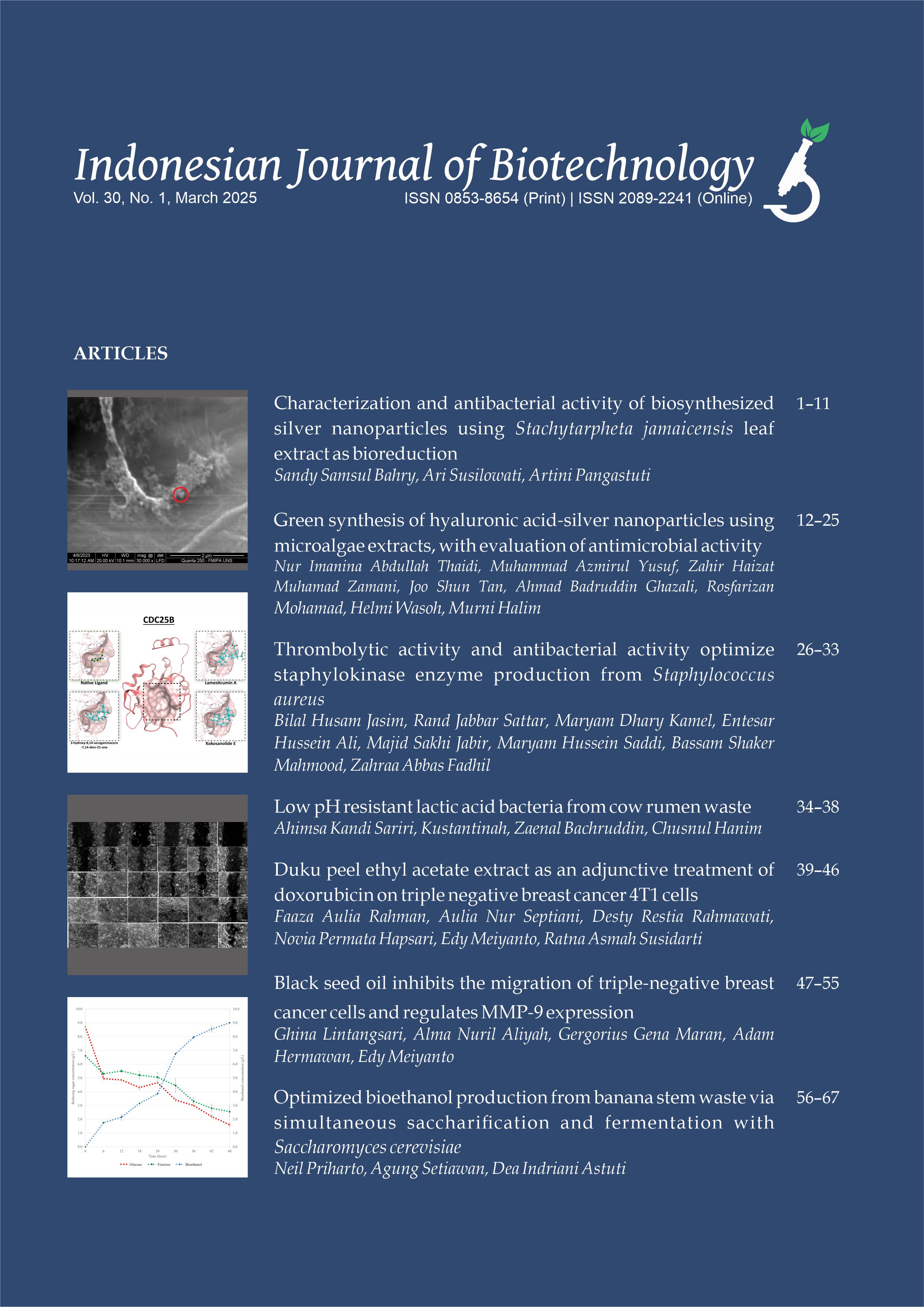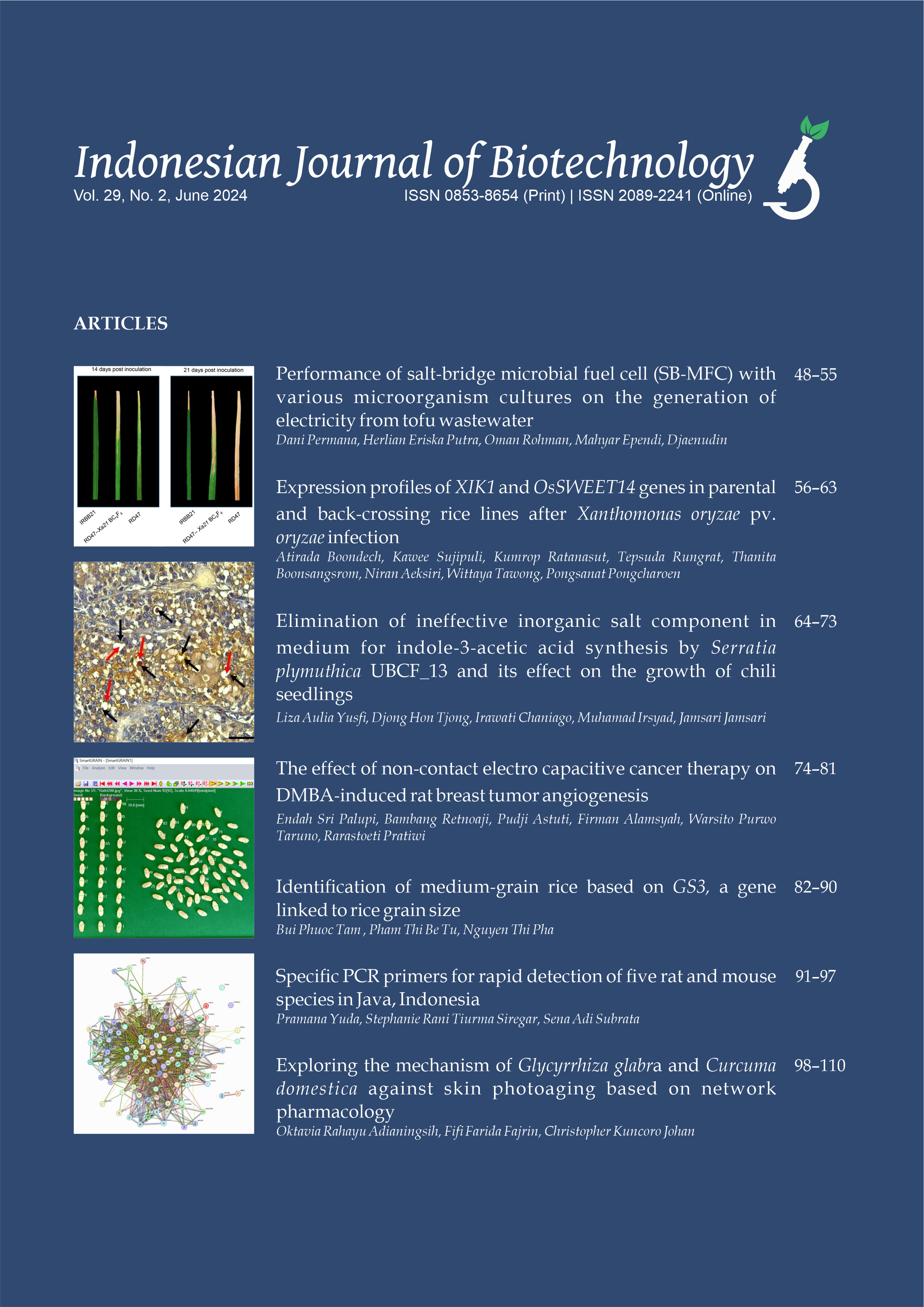Duku peel ethyl acetate extract as an adjunctive treatment of doxorubicin on triple negative breast cancer 4T1 cells
Faaza Aulia Rahman(1), Aulia Nur Septiani(2), Desty Restia Rahmawati(3), Novia Permata Hapsari(4), Edy Meiyanto(5), Ratna Asmah Susidarti(6*)
(1) Cancer Chemoprevention Research Center (CCRC) Faculty of Pharmacy Universitas Gadjah Mada, Yogyakarta, Indonesia
(2) Cancer Chemoprevention Research Center (CCRC) Faculty of Pharmacy Universitas Gadjah Mada, Yogyakarta, Indonesia
(3) Cancer Chemoprevention Research Center (CCRC) Faculty of Pharmacy Universitas Gadjah Mada, Yogyakarta, Indonesia
(4) Cancer Chemoprevention Research Center (CCRC) Faculty of Pharmacy Universitas Gadjah Mada, Yogyakarta, Indonesia
(5) Laboratory of Macromolecular Engineering, Department of Pharmaceutical Chemistry, Faculty of Pharmacy, Universitas Gadjah Mada, Yogyakarta, Indonesia
(6) Cancer Chemoprevention Research Center (CCRC) Faculty of Pharmacy Universitas Gadjah Mada, Yogyakarta, Indonesia; Laboratory of Medicinal Chemistry, Department of Pharmaceutical Chemistry, Faculty of Pharmacy, Universitas Gadjah Mada, Indonesia
(*) Corresponding Author
Abstract
Keywords
Full Text:
PDFReferences
Abdallah HM, Mohamed GA, Ibrahim SR. 2022. Lansium domesticum—A fruit with multibenefits: Traditional uses, phytochemicals, nutritional value, and bioactivities. Nutrients 14(7):1531. doi:10.3390/nu14071531.
Alif I, Utomo RY, Ahlina FN, Nugraheni N, Hermansyah D, Putra A, Meiyanto E. 2021. Immunopotentiation of galangal (Alpinia galanga L.) when combined with T-cells against metastatic triple-negative breast cancer, MDAMB 231. J. Appl. Pharm. Sci. 11(11):053–061. doi:10.7324/JAPS.2021.1101107.
Almansour NM. 2022. Triple-negative breast cancer: A brief review about epidemiology, risk factors, signaling pathways, treatment and role of artificial intelligence. Front. Mol. Biosci. 9:836417. doi:10.3389/fmolb.2022.836417.
Boutros R, Lobjois V, Ducommun B. 2007. CDC25 phosphatases in cancer cells: Key players? Good targets? Nat. Rev. Cancer 7:495–507. doi:10.1038/nrc2169.
Chandrashekar DS, Karthikeyan SK, Korla PK, Patel H, Shovon AR, Athar M, Netto GJ, Qin ZS, Kumar S, Manne U, Crieghton CJ, Varambally S. 2022. UALCAN: An update to the integrated cancer data analysis platform. Neoplasia (United States) 25:18–27. doi:10.1016/j.neo.2022.01.001.
Chou TC. 2010. Drug combination studies and their synergy quantification using the choutalalay method. Cancer Res. 70(2):440–446. doi:10.1158/0008 5472.CAN091947.
Daina A, Michielin O, Zoete V. 2019. SwissTargetPrediction: updated data and new features for efficient prediction of protein targets of small molecules. Nucleic Acids Res. 47(W1):W357–W364. doi:10.1093/nar/gkz382.
Fadhilah K, Wahyuono S, Astuti P. 2021. A bioactive compound isolated from duku (Lansium domesticum Corr) fruit peels exhibits cytotoxicity against T47D cell line. F1000Research 9:3. doi:10.12688/f1000research.21072.2.
Haryanti S, Zulfin UM, Salsabila IA, Wulandari F, Meiyanto E. 2022. The cytotoxic and antimigratory properties of Caesalpinia sappan and Ficus septica, in combination with doxorubicin on 4T1 TNBC cells with nephroprotective potential. Asian Pacific J. Cancer Prev. 23(2):743–752. doi:10.31557/APJCP.2022.23.2.743.
Hermawan A, Putri H, Utomo RY. 2021. Exploration of targets and molecular mechanisms of cinnamaldehyde in overcoming fulvestrant-resistant breast cancer: A bioinformatics study. Netw. Model. Anal. Heal. Informatics Bioinforma. 10:30. doi:10.1007/s13721021003039.
Ikawati M, Jenie RI, Utomo RY, Amalina ND, Nur Ilmawati GP, Kawaichi M, Meiyanto E. 2020. Genistein enhances cytotoxic and antimigratory activities of doxorubicin on 4T1 breast cancer cells through cell cycle arrest and ROS generation. J. Appl. Pharm. Sci. 10(10):095–104. doi:10.7324/JAPS.2020.1010011.
Kaur P, Nagaraja GM, Zheng H, Gizachew D, Galukande M, Krishnan S, Asea A. 2012. A mouse model for triple-negative breast cancer tumor-initiating cells (TNBCTICs) exhibits similar aggressive phenotype to the human disease. BMC Cancer 12:120. doi:10.1186/1471240712120.
Labibah Q, Tun KN, Aminah NS, Kristanti AN, Ramadhan R, Takaya Y, Abdullah CA, Masarudin MJ. 2021. Cytotoxic constituent in the fruit peel of Lansium domesticum. Rasayan J. Chem. 14(2):1336–1340. doi:10.31788/RJC.2021.1426044.
Leal MF, Ribeiro HF, Rey JA, Pinto GR, Smith MC, MoreiraNunes CA, Assumpção PP, Lamarão LM, Calcagno DQ, Montenegro RC, Burbano RR. 2016. YWHAE silencing induces cell proliferation, invasion and migration through the upregulation of CDC25B and MYC in gastric cancer cells: New insights about YWHAE role in the tumor development and metastasis process. Oncotarget 7(51):85393– 85410. doi:10.18632/oncotarget.13381.
Manjunath M, Choudhary B. 2021. Triple-negative breast cancer: A run-through of features, classification and current therapies (Review). Oncol. Lett. 22(1):512. doi:10.3892/ol.2021.12773.
Mayanti T, Zulfikar, Fawziah S, Naini AA, Maharani R, Farabi K, Nurlelasari, Yusuf M, Harneti D, Kurnia D, Supratman U. 2023. New triterpenoids from Lansium domesticum Corr. cv kokossan and their cytotoxic activity. Molecules 28(5):2144. doi:10.3390/molecules28052144.
Meiyanto E, Hermawan A, Anindyajati. 2012. Natural products for cancer-targeted therapy: Citrus flavonoids as potent chemopreventive agents. Asian Pacific J. Cancer Prev. 13(2):427–436. doi:10.7314/APJCP.2012.13.2.427.
Mollah F, Varamini P. 2021. Overcoming therapy resistance and relapse in TNBC: Emerging technologies to target breast cancerassociated fibroblasts. Biomedicines 9(12):1921. doi:10.3390/biomedicines9121921.
Nugraheni N, Ahlina FN, Salsabila IA, Haryanti S, Meiyanto E. 2021. Antisenescence activity of indonesian black pepper essential oil (Piper nigrum l.) on ovarian CHO-K1 and fibroblast NIH-3T3 cells. Thai J. Pharm. Sci. 45(3):187–194. doi:10.56808/3027 7922.2489.
Singh DD, Yadav DK. 2021. TNBC: Potential targeting of multiple receptors for a therapeutic breakthrough, nanomedicine and immunotherapy. Biomedicines 9(8):876. doi:10.3390/biomedicines9080876.
Sung H, Ferlay J, Siegel RL, Laversanne M, Soerjomataram I, Jemal A, Bray F. 2021. Global Cancer Statistics 2020: GLOBOCAN estimates of incidence and mortality worldwide for 36 cancers in 185 countries. CA. Cancer J. Clin. 71(3):209–249. doi:10.3322/caac.21660.
Tripathi V, Jaiswal P, Verma R, Sahu K, Majumder SK, Chakraborty S, Jha HC, Parmar HS. 2023. Therapeutic influence of simvastatin on MCF7 and MDAMB231 breast cancer cells via mitochondrial depletion and improvement in chemosensitivity of cytotoxic drugs. Adv. Cancer Biol. Metastasis 9:100110. doi:10.1016/j.adcanc.2023.100110.
van der Zanden SY, Qiao X, Neefjes J. 2021. New insights into the activities and toxicities of the old anticancer drug doxorubicin. FEBS J. 288(21):6095– 6111. doi:10.1111/febs.15583.
Verdonk ML, Cole JC, Hartshorn MJ, Murray CW, Taylor RD. 2003. Improved protein-ligand docking using GOLD. Proteins Struct. Funct. Genet. 52(4):609–623. doi:10.1002/prot.10465.
Wang T, Lu J, Wang R, Cao W, Xu J. 2022. TOP2A promotes proliferation and metastasis of hepatocellular carcinoma regulated by miR1443p. J. Cancer 13(2):589–601. doi:10.7150/jca.64017.
Won KA, Spruck C. 2020. Triplenegative breast cancer therapy: Current and future perspectives. Int. J. Oncol. 57(6):1245–1261. doi:10.3892/ijo.2020.5135.
Wulandari F, Ikawati M, Kirihata M, Kato JY, Meiyanto E. 2021. Curcumin analogs, PGV1 and CCA1.1 exhibit antimigratory effects and suppress MMP9 expression on WiDr cells. Indones. Biomed. J. 13(3):271– 280. doi:10.18585/inabj.v13i3.1583.
Yin L, Duan JJ, Bian XW, Yu SC. 2020. Triplenegative breast cancer molecular subtyping and treatment progress. Breast Cancer Res. 22(1):61. doi:10.1186/s13058020012965.
Zulfin U, Rahman A, Hanifa M, Utomo R, Haryanti S, Meiyanto E. 2021. Reactive oxygen species and senescence modulatory effects of rice bran extract on 4T1 and NIH3T3 cells cotreatment with doxorubicin. Asian Pac. J. Trop. Biomed. 11(4):174. doi:10.4103/22211691.310204.
Article Metrics
Refbacks
- There are currently no refbacks.
Copyright (c) 2025 The Author(s)

This work is licensed under a Creative Commons Attribution-ShareAlike 4.0 International License.









